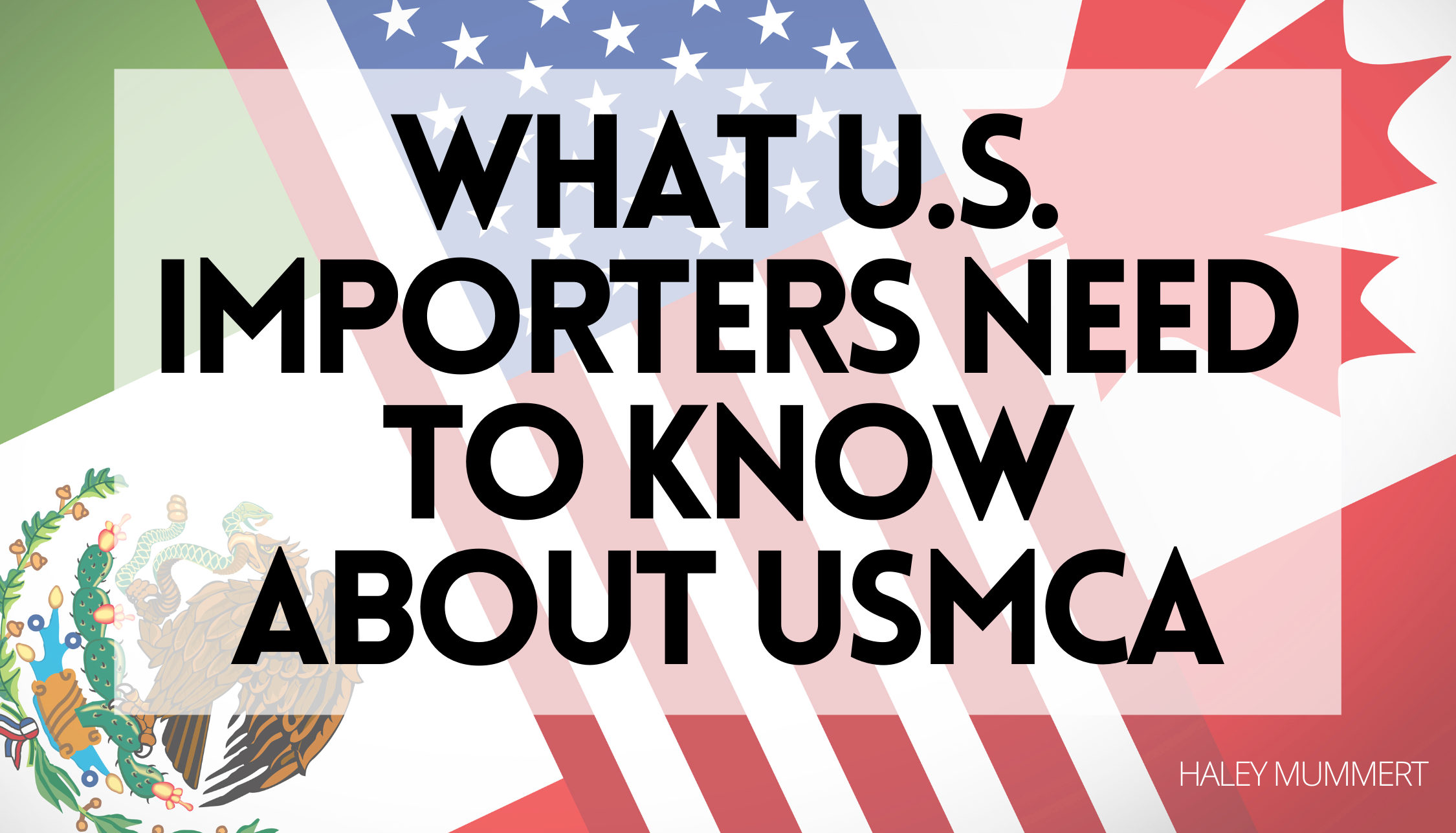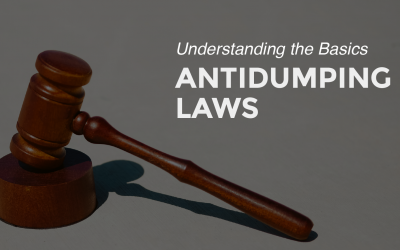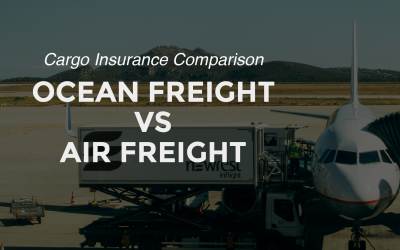The United States Mexico Canada Agreement (USMCA) is an updated version of the North American Free Trade Agreement (NAFTA). USMCA was implemented on July 1, 2020.
Over the last couple of years, the U.S. government has been working with Canada and Mexico to revamp the North American Free Trade Agreement (NAFTA). Now that agreements have been made and the newly titled United States Mexico Canada Agreement (USMCA) went into effect on July 1, 2020, we can take a look at some of the changes importers can expect.
Depending on which of the involved countries you are referring to, the new agreement may be referred to by different acronyms.
- The United States refers to the agreement as USMCA.
- Canada refers to the agreement as CUSMA.
- Mexico refers to the agreement as T-MEC.
Altered Rules of Origin for USMCA
Rules of Origin take into account where goods are produced and what materials are used to produce them. Rules of Origin are significant since duties and restrictions in many cases depend upon the source of imports.
Rules of Origin must be met under USMCA to determine if a product will qualify for a reduced duty. There are changes in the rules of origin of these specific sectors:
- Automobiles
- Information technologies and communications
- Pharmaceuticals
- Healthcare products
- Cosmetic products
- Chemicals
After July 1st, 2020, a Certification of Origin with specific data elements will be required rather than a NAFTA Certificate to claim a duty reduction. NAFTA Certificates will not be accepted to reduce duty under this new agreement.
Importers getting their USMCA certifications should reach out to their suppliers to ensure they are:
- Aware of the new trade agreements’ implementation date
- Re-evaluating their products to ensure they meet the new rules of origin
- Prepared to provide the new certification
If a product qualified under NAFTA, it doesn’t necessarily qualify under USMCA. Refer to the new Rules of Origin for your products to ensure that they qualify as an originating good. The new agreement has added specific exemptions for products to meet before they would qualify for reduced duty. This applies to HTS codes with headings 04.01 through 04.10.
Under NAFTA, a Certificate of Origin had to be completed and signed by the exporter of the goods. Only importers who possess a valid Certificate of Origin signed by the exporter could claim preferential tariff treatment for originating goods. By contrast, the USMCA provides that an importer, exporter, or producer may complete a certification of origin and claim preferential tariff treatment subject to certain requirements.
Canada and the United States will begin allowing importers to complete a certification of origin immediately upon the USMCA implementation. However, Mexico will have up to three years and six months after the USMCA implementation to apply this requirement.
If you complete the certification of origin, you are confirming that you:
- Researched the products
- Confirmed that the products meet the rules of origin under USMCA
- Have proof that the products meet the rules of origin of USMCA
If you have Advance Rulings for origin issued under NAFTA, they will not be valid under USMCA because the NAFTA rules of origin are different from the USMCA rules of origin. You will need to apply for new advance rulings.
The USMCA includes increased De Minimis levels. De Minimis allows shipments with a value below a certain threshold to enter the U.S. duty-free and in some cases tax-free. The USMCA changed the threshold within which low-value goods could enter the U.S. duty-free to $800 USD.
Required Data Elements for USMCA
There is no formal certificate for USMCA, so importers can list the required data elements on a commercial invoice or another document that accompanies the shipment. Previous NAFTA certificates and certification documentation under USMCA must be kept for a minimum of five years.
A certification of origin must include the following minimum data elements:
- Importer, Exporter, or Producer
Indicate whether the certifier is the exporter, producer, or importer. - Certifier
Provide the certifier’s name, title, address, phone number, and email address. - Exporter
Provide the exporter’s name, address, e-mail address, and phone number if different from the certifier. This is not required if the producer is completing the certification of origin and does not know the identity of the exporter. - Producer
Provide the producer’s name, address, e-mail address, and phone number, if different from the certifier or exporter or, if there are multiple producers, provide a list of producers. - Importer
Provide the importer’s name, address, email address, and phone number. - Description and HTS Code
Provide a description of the good and the HTS code of the good. The description should be sufficient to relate it to the good covered by the certification. If the certification of origin covers a single shipment of a good, indicate, the invoice number related to the exportation. - Origin Criteria
Specify the origin criteria under which the good qualifies found in Chapter 4 of the USMCA. - Blanket Period
Include the period if the certification covers multiple shipments of identical goods for a specified period of up to 12 months. - Authorized Signature and Date
The certification must be signed and dated by the certifier and accompanied by the
following statement:
“I certify that the goods described in this document qualify as originating and the information contained in this document is true and accurate. I assume responsibility for proving such representations and agree to maintain and present upon request or to make available during a verification visit, documentation necessary to support this certification.”
Obligations of Importers Claiming Preferential Tariff Treatment
The obligations of importers claiming preferential tariff treatment under USMCA are generally the same as those under NAFTA.
The importer must:
- State that the good is originating based on a valid certification of origin as part of the import documentation.
- Have the certification in its possession at the time the statement is made.
If no claim for preferential tariff treatment is made at the time of importation, importers can request preferential tariff treatment no later than one year after the date of importation.
In order to claim preferential duty rates, the goods must be transported directly from the country of origin or remain in Customs’ control when it travels through a region that is not part of the free trade agreement.
The USMCA authorizes the imposition of additional obligations on importers, which were not provided for in NAFTA, including authorizing the request for importers to demonstrate that goods have been shipped in accordance with transit and transshipment Rules of Origin.
Importers may be requested to:
- Provide documentation indicating the shipping route and all points of shipment and transshipment prior to the importation of the good; and, if the good was shipped outside the territories of the Parties.
- Provide documents demonstrating that the goods remained under Customs control while outside the territories of the Parties. A similar requirement was included in the TPP.
If the claim for preferential tariff treatment is based on a certification of origin completed by a producer that is not the exporter of the good, the importer must demonstrate on the request of the importing Party that the good did not undergo further production or any other operation other than unloading, reloading or any other operation necessary to preserve it in good condition or to transport the good to the importing Party.







![[Video] What Are Antidumping and Countervailing Duties?](https://traderiskguaranty.com/trgpeak/wp-content/uploads/2024/03/what-are-antidumping-countervailing-duties-YT-400x250.png)